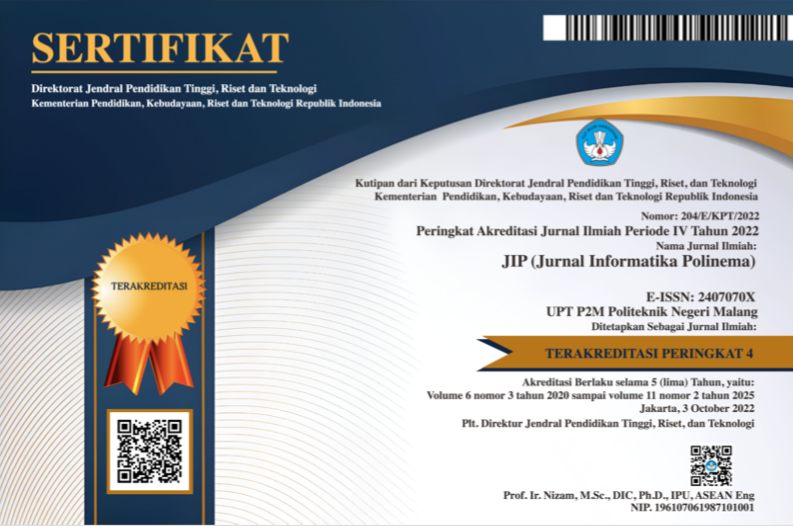IMPLEMENTATION OF AES-128 BIT ENCRYPTION ALGORITHM ON RFID DATA ON 802.11n and 802.11ac NETWORKS USING MQTT-BASED REMOTE MONITORING
Abstract
Message Queue Telemetry Transport or commonly called MQTT is a protocol for communication that is machine to machine or M2M and works on the seventh layer or application and is a lightweight message. The MQTT protocol by default only has an authentication mechanism, by default it is still unencrypted. Then a research on the implementation of the AES-128 bit encryption algorithm with an mqtt-based 802.11n connection was carried out on an automatic door RFID lock system with remote monitoring. In this study, the reading of the RFID sensor was carried out using scenarios with encryption and without encryption with 50 data transmissions. The hardware used in this research is the NodeMCU ESP8266 microcontroller, 5V adapter, and MFRC522 sensor which is implemented on Tp-link Archer C54 and Tp-link TL-MR100. The aim of this study was to determine the effect of the AES encryption process of 128-bit RFID data on the NodeMCU microcontroller via the MQTT protocol using the 802.11n Archer network and the 802.11n MR100 network on RAM usage, delay and throughput. In the RAM usage parameter, the 802.11n Archer router type, the encryption scenario results in an average remaining RAM of 18,829 KB. While the scenario without encryption is 23.225 KB. The router type is 802.11n MR100, the encryption scenario produces an average remaining RAM of 18,828 KB. While the scenario without encryption is 23.287 KB. There was an increase in the use of 32 KB of RAM from the use without encryption and encryption, namely on the 802.11n Archer router 23%, while on the 802.11n MR100 router it was 24%. In the delay parameter, the 802.11n Archer router type, encryption data transfer has an average delay of 137.79 ms. Meanwhile, data transfer without encryption is 128.08 ms. Router type 802.11n MR100, encrypted data transfer has an average delay of 145.71 ms. Meanwhile, data transfer without encryption is 126.45 ms. There was an increase in delay from using without encryption and encryption, namely on the 802.11n Archer router 8%, while on the 802.11 MR100 router it was 15%. In the throughput size parameter, the 802.11n Archer router type, the encryption scenario has a throughput of 1.659 KB/s while without encryption it is 0.491 KB/s. Type 802.11n MR100, the encryption scenario has a throughput of 1.586 KB/s while without encryption it is 0.513 KB/s. There is an increase in throughput from using both unencrypted and encrypted.
Downloads
References
Amarudin, A., Saputra, D. A., & Rubiyah, R. (2020). Rancang Bangun Alat Pemberi Pakan Ikan Menggunakan Mikrokontroler. Jurnal Ilmiah Mahasiswa Kendali Dan Listrik, 1(1), 7–13.
Andy, S., & Rahardjo, B. (2018). Keamanan Komunikasi Pada Protokol MQTT untuk Perangkat IoT. Prosiding-Seminar Nasional Teknik Elektro UIN Sunan Gunung Djati Bandung, 176–184.
Darwis, D., Prabowo, R., & Hotimah, N. (2018). Kombinasi Gifshuffle, Enkripsi AES dan Kompresi Data Huffman Untuk Meningkatkan Keamanan Data. Jurnal Teknologi Informasi Dan Ilmu Komputer (JTIIK), 5(4), 389–394.
Ghozali, Imam. (2018). Aplikasi Analisis Multivariate Dengan Program IBM SPSS 25. Semarang : Badan Penerbit-UNDIP.
Meko, D. A. (2018). Perbandingan Algoritma DES, AES, IDEA Dan Blowfish dalam Enkripsi dan Dekripsi Data. Jurnal Teknologi Terpadu (JTT), 4(1).
Muharram, F., Aziz, H., & Manga, A. R. (2018). Analisis Algoritma pada Proses Enkripsi dan Dekripsi File Menggunakan Advanced Encryption Standard (AES). Prosiding SAKTI (Seminar Ilmu Komputer Dan Teknologi Informasi), 3(2), 112–115.
Oktaviani, R., Nazwirman, N., Djamaludin, D., & Windyasari, V. S. (2020). Aplikasi Sistem Parkir Kendaraan Bermotor Menggunakan Teknologi Radio Frequency Identification (RFID) Di Universitas Islam Syekh Yusuf Tangerang. Jurnal Ilmiah Fakultas Teknik, 1(2), 96–103.
Prameshwari, A., & Sastra, N. P. (2018). Implementasi Algoritma Advanced Encryption Standard (AES) 128 Untuk Enkripsi dan Dekripsi File Dokumen. Jurnal Eksplora Informatika, 8(1), 52–58.
Purwanto, H. (2021). Penerapan Keamanan Basis Data Dengan Teknik Enkripsi. JSI (Jurnal Sistem Informasi) Universitas Suryadarma, 1(1).
Rizqulloh, M. A., Somantri, Y., Pramudita, R., & Ramelan, A. (2021). Implementasi algoritma block cipher four pada mikrokontroler STM32F103C8T6: Implementation of block cipher four algorithm on STM32F103C8T6 microcontroller. JITEL (Jurnal Ilmiah Telekomunikasi, Elektronika, Dan Listrik Tenaga), 1(2), 175–188.
Roihan, A., Permana, A., & Mila, D. (2016). Monitoring kebocoran gas menggunakan mikrokontroler arduino uno dan esp8266 berbasis internet of things. Innovative Creative and Information Technology, 2(2), 170–183.
Sutomo, B., & Saputri, T. A. (2018). Remote Home Monitoring Menggunakan Protokol MQTT. Prosiding Seminar Nasional Darmajaya, 1(1), 146–153.
Zein, S., L, Yasfira., R, Ghozi., E, Harahap., FH, Badruzzaman., & D, Darmawan (2019). Pengolahan Dan Analisis Data Kuantitatif Menggunakan Aplikasi SPSS. Jurnal Teknologi Pendidikan dan Pembelajaran,1,4.
Zubaidi, A., Sardi, R. I., & Jatmika, A. H. (2021). Pengamanan Internet of Things Berbasis NodeMCU Menggunakan Algoritma AES pada Arsitektur Web Service REST. Edumatic: Jurnal Pendidikan Informatika, 5(2), 252–260.
Copyright (c) 2023 M. Apriannur, Dodon Turianto Nugrahadi, Andi Farmadi, Muhammad Itqan Mazdadi, Fatma Indriani

This work is licensed under a Creative Commons Attribution-NonCommercial 4.0 International License.
Copyright for articles published in this journal is retained by the authors, with first publication rights granted to the journal. By virtue of their appearance in this open access journal, articles are free to use after initial publication under the International Creative Commons Attribution-NonCommercial 4.0 Creative Commons CC_BY_NC.
















